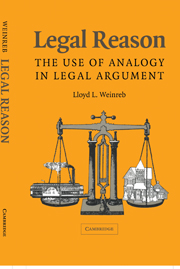Book contents
- Frontmatter
- Contents
- Preface
- Introduction
- 1 Analogy and Inductive and Deductive Reasoning
- 2 Steamboats, Broadcast Transmissions, and Electronic Eavesdropping
- 3 Analogical Legal Reasoning
- 4 Analogical Reasoning, Legal Education, and the Law
- Appendix A Note on Analogical Reasoning
- Appendix B Biographical Notes
- Notes
- Index
4 - Analogical Reasoning, Legal Education, and the Law
Published online by Cambridge University Press: 05 June 2012
- Frontmatter
- Contents
- Preface
- Introduction
- 1 Analogy and Inductive and Deductive Reasoning
- 2 Steamboats, Broadcast Transmissions, and Electronic Eavesdropping
- 3 Analogical Legal Reasoning
- 4 Analogical Reasoning, Legal Education, and the Law
- Appendix A Note on Analogical Reasoning
- Appendix B Biographical Notes
- Notes
- Index
Summary
Analogical reasoning
How then do we do it? If an analogy is neither a suppressed deductive argument nor, certainly, an inductive argument, what is it, and why do we – ought we – have confidence in the conclusion? How do we account for perception of the complex similarities on which an analogical legal argument rests: the similarity between a steamboat and an inn, on which the court relied in Adams; between a “live” performance and the reception and transmission of a radio broadcast, as in Jewell-LaSalle; and between a telephone booth and a business office, a friend's apartment, and a taxicab, as in Katz? What guides the selection and reliance on one similarity among all the others that might be mentioned and a multitude of dissimilarities? The theories dismissive of analogical reasoning that are discussed in previous chapters assume that the logic of deductive and inductive argument defines the bounds within which those questions must be answered; no answer being found there, they conclude that there is none and that an analogical argument, thus unconstrained, is too weak to support the weighty consequences of an adjudication. Answers are found, however, not in abstract reason but directly in our experience of the world.
The ability to reason analogically is a rich subject for investigation and analysis. Full discussion of the issues that it presents and of experimental results and explanatory theories is beyond the scope of this book.
- Type
- Chapter
- Information
- Legal ReasonThe Use of Analogy in Legal Argument, pp. 123 - 162Publisher: Cambridge University PressPrint publication year: 2005



